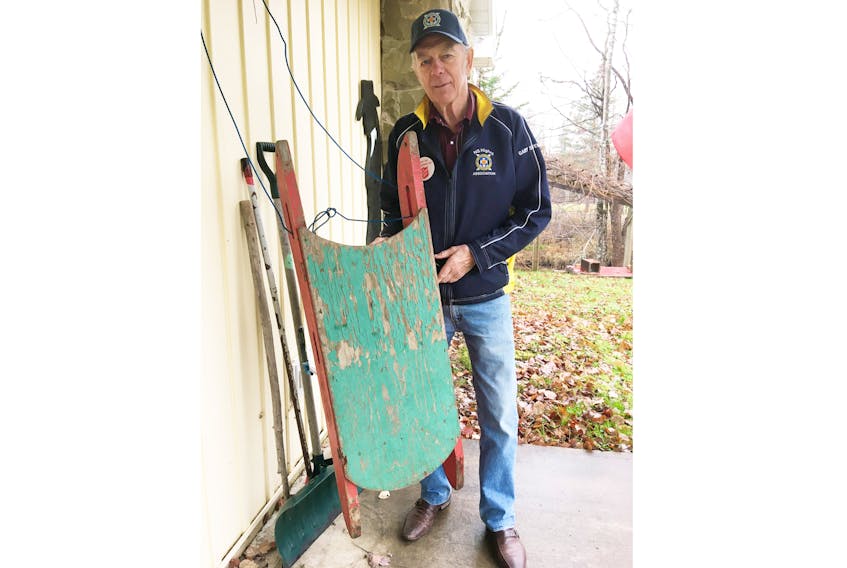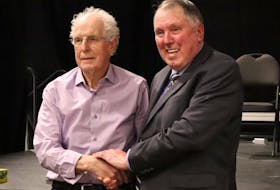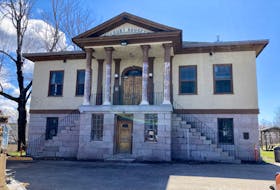If you lived towards the top of Acadia Avenue, possibly on Hoyt or Poole or Coll, the short avenues off Poplar Street, there was no mistaking when Christmas was in the air.
Gary Stewart was a child on Coll and a teenager when his family crossed Poplar Street to live on Poole Avenue. He remembers whole families pulling together to present Christmas.
“At our house we’d be at the kitchen table at night, making Yule logs with birch, candles and pine cones. We gave them out as gifts. There’d have been no point trying to sell them in the fifties because nobody had any money,” said Stewart, who still makes a few logs each year.
Stellarton had a wealth of small grocery stores at the time and Stewart has a receipt from one of them: Fry’s Cocoa, a pound of bacon, a box of salt, yeast cakes, onions, a half dozen eggs, stew meat, smoked fillets, tomato soup and two grapefruit... Total: $4.90.
“Five dollars bought more than it does today but you worked hard for it.”
The Asphalt of the 1950s was full of growing boys and girls, most of them the children and grandchildren of coal miners.
“A good many of the fathers bought a case of beer before they bought food on payday. They were good men who worked hard underground and you couldn’t blame them because they never knew if they’d see another weekend.”
The deep roots of the families meant they were steeped in knowledge of the dangerous, methane-rich Pictou County mines but in the 1950s, the more immediate worry was how long the mines would hold out. It was a worry families tried to put on the shelf for the Christmas season.
“We’d go out visiting, to the neighbours, to the grandparents, to all our relations. We didn’t have far to go because a lot of them were in The Asphalt. We’d bring a little gift and there was always something nice to eat.”
Stewart believes the most decorated home in The Asphalt would have had three candle-lit wreaths in the windows.
“There were so few electrical outlets in the old houses, lighting three windows was really something. Nobody hung strings of outdoor lights, nobody could afford that, but most everybody put up a little something for Christmas.”
The older kids in a family would head out into the nearby woods – where the homes of Valley Woods now stand – cut down a tree and drag it home.
“We’d make paper maché angels and bells from egg cartons to hang on the tree. Any little bit of ribbon or nice paper was put aside for Christmas. Some people strung popcorn but we never had it.”
Stewart’s father, Garfield, who worked in the Albion and MacGregor mines, was particularly handy at making Christmas toys.
“He always made sleds and he also made hitches for them which meant you could turn them and steer them. The kids in The Asphalt had the best sleds around.”
The other gifts he remembers were generally small, such as a gun and holster, a jackknife or maybe something second hand.
“Nobody thought anything of getting a used pair of skates, painted up and with new laces. It was the same with a used bicycle.”
Ribbon candy, chewing gum and an orange were the staples in the stockings.
The smells of those childhood Christmases still linger with Stewart.
“We were used to the beautiful smell of homemade bread but at Christmas there were also pies, puddings and custards. My mother made the nicest Scotch cookies and gingerbread.”
His father’s sister, Beryl Nicholson, roasted a goose for her family’s Christmas dinner each year.
“Then she’d make doughnuts, frying them in goose fat. The kids would come from all over The Asphalt to eat them.”
She also used wooden orange crates and brick-patterned crépe paper to build a decorative fireplace for her living room at Christmas.
“As kids, we thought it was the greatest, coziest place in the world.”
Stewart does not specifically remember the Christmas of 1951, a few months before his sixth birthday, but he suspects it was a happy time with children receiving balls and dolls and families visiting. What is etched in his mind is the day a few weeks after Christmas - January 14, 1952, when the MacGregor mine exploded.
“I remember people coming to the school and certain children were called to get their things and leave. My cousin and his older sister were called out. The rest of us wondered what was going on.”
Nineteen miners died in that explosion.
“My cousins lost their father and my aunt lost her husband. My father was a draegerman and he had to go down to bring out the bodies, including my uncle who was also his best friend.”
Stewart also remembers the terrible winter storm that followed the explosion.
“In those days the miners walked paths through the town to get to the mines. Not many people owned cars and most who did never drove them in winter so the town had very little in the way of snow clearing equipment.”
He recalls watching miners, dressed in suits and salt and pepper caps, standing five or six abreast shovelling through snow drifts in The Asphalt.
“There were about eight of those killed who were from The Asphalt and the bodies went first to New Glasgow stadium and then back to their homes. Wearing their suits out of respect for the dead, the miners shovelled the streets so people could get to the dead miners’ homes to pay their respects.”
While the men cleared the streets, women went from house to house, “doing for the widows and children.”
“It was the saddest thing I ever saw. The men all out shovelling and the women crying as they went into houses, carrying a loaf of bread or a pot of something.”
Besides the loss of friends and workmates, the explosion cast doubt over the continued operation of the mines; closures followed in the next few years. Seasoned miners moved from mine to mine until finally the McBean Mine in Thorburn also closed.
“Some fathers went to Hamilton to the steel plant and others, like mine, went to Elliot Lake to the uranium mines. Sometimes the families followed them but in our case my father’s lungs were dusted with uranium so he was sent home and got on at Trenton steelworks.”
Those 1950s Christmases in The Asphalt were tough times but that is not what Stewart, who works three shifts a week at the Salvation Army’s Christmas kettle campaign, remembers.
“For us kids, we were home from school and it was the best time of year. We’d be out coasting on Fleming’s hill or Forbes’ hill, behind Maple Street. Some of the kids would be on a car hood or a washing machine cover and there were lots of injuries.”
If they were not coasting they’d be skating on Geordie White’s pond (Valley Woods park) which was much bigger than it is today, according to Stewart.
“If you came home to a cup of hot cocoa with a few marshmallows on top, you thought life couldn’t get any better.”
Rosalie MacEachern is a Stellarton resident and freelance writer. She seeks out people who work behind the scenes on hobbies or jobs that they love the most. If you know someone you think she should profile in an upcoming article, she can be reached at [email protected]









